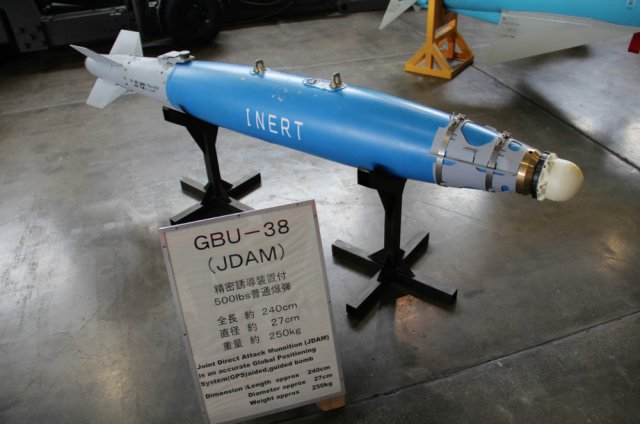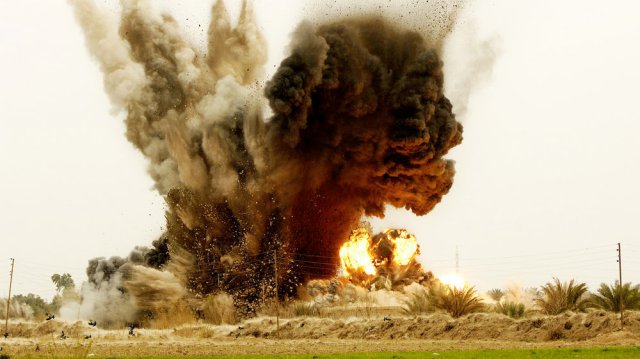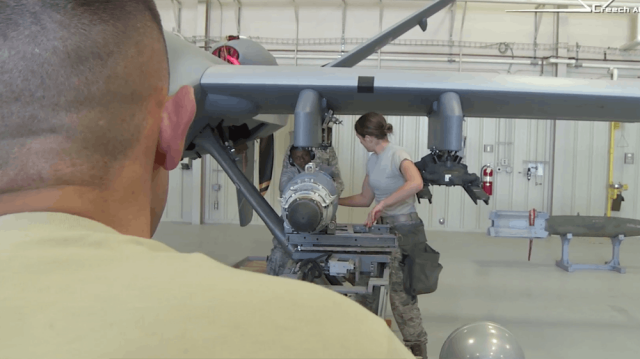 The announcement that testing of GBU-38 JDAM guided-bombs delivered using the American hunter-killer MQ-9 Reaper UAV got underway this month is a reminder that drone warfare is getting much cheaper and far more precise. At US$20,000 each, the GBU-38 costs just a fraction of the $110,000 AGM-114 Hellfire missile which the MQ-9 currently delivers, with the additional strength that it can be used in inclement weather.
The announcement that testing of GBU-38 JDAM guided-bombs delivered using the American hunter-killer MQ-9 Reaper UAV got underway this month is a reminder that drone warfare is getting much cheaper and far more precise. At US$20,000 each, the GBU-38 costs just a fraction of the $110,000 AGM-114 Hellfire missile which the MQ-9 currently delivers, with the additional strength that it can be used in inclement weather.
The reason the AGM-114 Hellfire missiles cannot be used in bad weather is that they rely on laser-guidance to the target, and this needs to be done by the opto-electronics of the firing aircraft, or “painting the target” by another airborne designator or ground-based troops. Without visibility, the Hellfire cannot home in on the reflected laser beam aimed at the target.
The GBU-38 bomb, unlike the two main current weapons deployed by the MQ-9 Reaper UAV (the laser-guided GBU-12 bomb and Hellfire missile), employs GPS to find its target and hence can be fired “blind” through cloud, rain or fog with remarkable accuracy.

The $2000 GBU-38 in action. Those are telephone poles to guage the size of the blast it delivers. The GBU-38 is a general-purpose, 500 pound, Mk 82 dumb bomb with an $18,000 GPS guidance system fitted, turning it into a surgically-accurate weapon delivering 192 pounds (89 kg) of Tritonal high explosive from a range of up to 15 miles (24 km). That’s on top of the MQ-9’s 1100 km range
The GBU-38 is a $2000 general-purpose, 500 pound, Mk 82 dumb bomb with an $18,000 guidance system fitted, turning it into a surgically-accurate weapon delivering 192 pounds (89 kg) of Tritonal high explosive from a range of up to 15 miles (24 km).
That 15 mile range is in addition to the MQ-9 Reaper’s range of 1,150 miles (1,850 km), making it ideal for loitering above the battlefield for hours, while providing surveillance, then striking when a target is identified.

Using the GBU-38 has other advantages other than accuracy in bad weather and cost, in the that it’s load time is almost half that of the currently used GBU-12 and Hellfire weapons, enabling the Reaper to get into the air some 15 minutes quicker. (Credit: U.S. Air Force)
Other than accuracy in bad weather and cost, another advantage of using the GBU-38 is that its load time is almost half that of the currently used GBU-12 and Hellfire weapons, enabling the Reaper to get into the air some 15 minutes quicker. Given that rapid deployment to hit targets that might only be available for a short window of time is a huge advantage, the new weapon will significantly add to the warfighter’s toolbox.
Some observers liken the rapid development of drones during the Iraq war to the evolution of the aircraft as a weapon of war during WW1. When the first World War began, aircraft were seen primarily as sources of ISR (Intelligence, Surveillance and Reconnaissance) but within four years, the attack capabilities of aircraft had changed war forever.
When the Iraq war began in 2003, America had just a handful of “drones,” but within a decade it had more than 10,000 pilotless aircraft in the arsenal and though the General Atomics MQ-9 only makes up a few hundred of those UAVs, it is both highly cost-efficient and lethal.
Source: New Atlas

What a strange article!!
Firstly, why compare the hellfire to the FBU-38 and not the GBU-12 also carried by the Reaper, but roughly half the price of the Hellfire.
Secondly, there are very few weapons in the inventory that can match the Hellfire during counter insurgency.
Thirdly, the reason the GBU-12 is lesser used, is the size of the weapon, which in the modern war isn’t required, and the finesse of a weapon such as the hellfire is far more appropriate.
Also, there is a time and a place for JDAM weapons, but in an age where civilian casualties are unacceptable (as it should be) using a weapon such as a JDAM should be a last resort to a laser guided weapon, in my humble opinion!
What a strange critique of an informative and concise article!!
The criticized report highlighted the two MAJOR advantages of the new FBU-38 standoff weapon system over the Hellfire for use on a Reaper : (1) GPS-guided ability to “blind fire” through rain/fog/cloud/target-not-in-line-of-site-at launch conditions and (2) the cost effectiveness at $20K per FBU-38 unit vs. $110K per Hellfire.
Then the major supposed FBU-38 disadvantage proposed “is the size of the weapon” versus the “finesse” of the Hellfire. It is not clear if the complaint is criticizing the larger gross weight of the FBU-38 or it’s employment of 192 pounds of high explosives vs. the Hellfire’s 18-20 pounds. but this “issue” is disingenuous in either case as the US does have standard bombs somewhat smaller than the Mark 82. I’m sure US advanced technology can be employed to employ a variety of standard Iron Bomb alternatives to the Mark 82 in situations where “finesse” is expected to be a major concern. But at least with the FBU-3x family, the option of matching the size of the bang to the size of the job can be easily done anywhere along the deployment pathway.